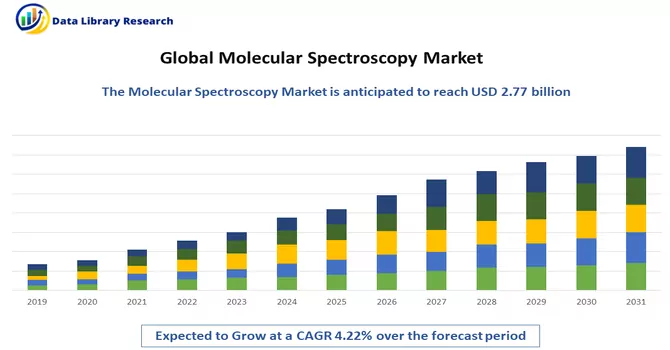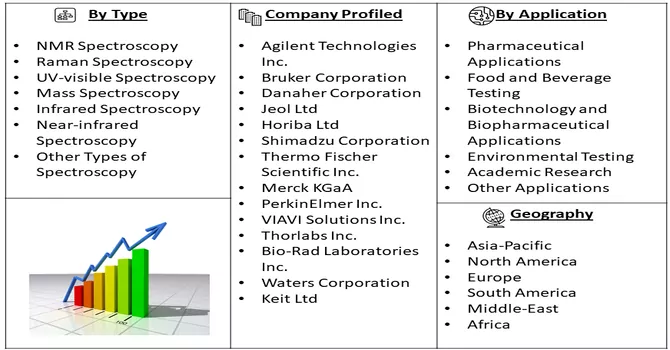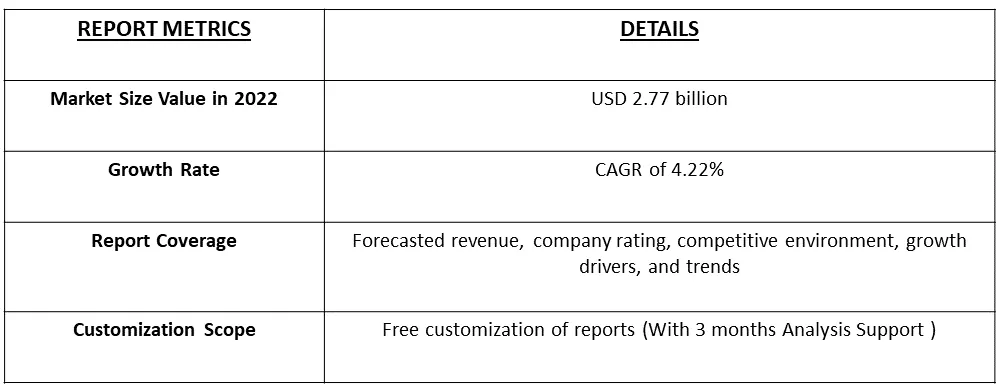The Molecular Spectroscopy Market size is currently valued at USD 2.77 billion in 2022, registering a CAGR of 4.22% during the forecast period (2023-2030).

Get Complete Analysis Of The Report - Download Free Sample PDF
The major factors driving the market include the rapid adoption in the pharmaceutical industry, penetration of MS technology in various verticals, and increased emphasis on the discovery of newer molecules by pharmaceuticals. Molecular spectroscopy is a branch of analytical chemistry and physics that focuses on the study of the interaction between matter and electromagnetic radiation, specifically within the context of molecules. It involves the measurement and interpretation of the way molecules absorb, emit, or scatter electromagnetic radiation, such as light, in order to gain insights into their structural, rotational, vibrational, and electronic properties.
Market Segmentation:
The Molecular Spectroscopy Market is Segmented
By Type of Spectroscopy :
Application :
Geography :
The report offers the value (in USD million) for all the above segments.

For Detailed Market Segmentation - Download Free Sample PDF
Molecular spectroscopy is increasingly being used in interdisciplinary research, where it complements other techniques such as mass spectrometry, microscopy, and chromatography to provide a comprehensive understanding of molecular systems. Moreover, advanced data analysis methods, including machine learning and artificial intelligence, are being integrated with spectroscopy to enhance the interpretation of complex spectral data and to automate the identification of spectral features.
Drivers:
Rapid Adoption in the Pharmaceutical Industry
The rapid adoption of spectroscopy in the pharmaceutical industry has led to improved research and development processes, reduced time-to-market for new drugs, and enhanced product quality and safety. It has become an integral part of pharmaceutical manufacturing, ensuring that medications are not only effective but also reliable and safe for patients. As the industry continues to evolve and innovate, spectroscopy is poised to play an even more significant role in shaping the future of pharmaceuticals.
Furthermore, an article published by Journal Frontiers, reported that spectroscopy is used to study the pharmacokinetics and pharmacodynamics of drugs in the body. The article also quoted that in vivo spectroscopy techniques, such as magnetic resonance imaging (MRI) and positron emission tomography (PET), provide insights into drug distribution, metabolism, and efficacy within living organisms. This information is crucial for optimizing dosing regimens and evaluating a drug's therapeutic effects. Thus, owing to such benefits, the market is expected to witness significant growth over the forecast period.
Increased Emphasis for Discovery of Newer Molecules by Pharmaceuticals
The pharmaceutical industry's increased emphasis on discovering newer molecules is driven by a commitment to innovation and addressing evolving healthcare challenges. Molecular spectroscopy, with its diverse range of techniques and applications, is an invaluable ally in the drug discovery process. It enables the rapid and comprehensive characterization of molecules, ensuring that promising candidates progress efficiently from the discovery stage to clinical development. As pharmaceutical companies continue to push the boundaries of drug discovery, the synergy between innovation and molecular spectroscopy is set to lead to groundbreaking advancements in healthcare. Thus, the market is expected to witness significant growth over the forecast period.
Restraints :
High Cost of Maintenance and Installation Charges and Low Number of Skilled Professionals
The acquisition of spectroscopic instruments typically involves a substantial upfront investment. These costs encompass the purchase of the equipment itself, peripheral devices, and software. This high initial expenditure can deter small and medium-sized enterprises (SMEs) and research institutions from adopting or upgrading their spectroscopy capabilities. Moreover, spectroscopy encompasses a wide array of techniques, each with its own complexities and nuances. Skilled professionals are required to operate and maintain these instruments effectively, interpret spectral data, and troubleshoot technical issues. The shortage of individuals with the requisite expertise can hinder the deployment of spectroscopy technologies. Thus, owing to above-mentioned reasons the growth of the studied market is expected to slowed down over the forecast period.
The global COVID-19 pandemic has inadvertently had a positive impact on the spectroscopy market, as scientists are increasingly exploring new applications of Raman spectroscopy for COVID-19 testing. An illustrative example of this is a research team at Northern Arizona University (NAU), which is actively developing an innovative SARS-CoV-2 testing technology based on single-molecule surface-enhanced Raman spectroscopy (SM-SERS). This project, titled "Development of a New Test for SARS-CoV-2 Using Single-Molecule Surface-Enhanced Raman Spectroscopy," received a substantial USD 200,000 grant from the National Science Foundation's Rapid Response Research (RAPID) funding program. Consequently, the heightened research and development efforts in the pharmaceutical sector, especially in the context of drug discovery and diagnostics, are poised to fuel a sustained increase in the demand for molecular spectroscopy. This trend is expected to persist throughout the forecast period.
Segmental Analysis :
NMR Spectroscopy Segment is Expected to Witness Significant Growth Over the Forecast Period
Nuclear magnetic resonance (NMR) spectroscopy is a powerful analytical chemistry technique used for both quality control and research purposes. It enables the determination of sample content, purity, and molecular structure, offering several advantages, including minimal sample preparation requirements and a non-destructive approach that preserves the integrity of the molecules under examination. In recent years, NMR spectroscopy has emerged as the preeminent method for elucidating the structures of organic compounds. Its versatility has led to widespread adoption across various application areas, including pharmaceuticals, biotechnology, biopharmaceuticals, food and beverage testing, environmental analysis, and research institutions. Moreover, NMR spectroscopy's role has expanded into biochemical and biological applications, encompassing hit and lead discovery, metabolite profiling, in vivo spectroscopy (MRS), and imaging (MRI). Notably, the field of NMR spectroscopy has witnessed several significant developments aimed at enhancing sensitivity and versatility, thereby broadening its range of applications. In October 2020, Bruker Corporation introduced the Fourier 80 system, a benchtop nuclear magnetic resonance (FT-NMR) spectrometer, with a European launch. Additionally, there are several promising innovations on the horizon that are anticipated to drive substantial market growth in the foreseeable future.
Pharmaceuticals Segment is Expected to Witness Significant Growth Over the Forecast Period
Molecular spectroscopy plays a fundamental role throughout the pharmaceutical journey, from the initial stages of drug discovery and development to the meticulous processes of quality control and stringent adherence to regulatory standards. Its multifaceted utility, unwavering accuracy, and non-invasive characteristics establish it as an indispensable pillar within pharmaceutical research and manufacturing. It is this very foundation that guarantees the creation of medications that are both safe and efficacious, ultimately benefiting patients on a global scale. The pharmaceutical industry's unceasing pursuit of innovation and advancement continually underscores the significance of molecular spectroscopy. This analytical technique, with its wide-ranging applications and precision, stands as a vanguard in the realm of scientific progress, guiding the development of pharmaceuticals and assuring their quality and integrity. In essence, as pharmaceutical science evolves, molecular spectroscopy will persist as a luminary in the field, illuminating the path of progress in drug development and ensuring the highest standards of quality assurance. Thus owing to above-mentioned reasons the segment is expected to witness significant growth over the forecast period.
North America Region is Expected to Witness Significant growth Over the Forecast Period
North America is at the forefront of driving the molecular spectroscopy market, owing to several key factors. These include the increased utilization of molecular spectroscopy in the pharmaceutical sector, a surge in funding for environmental testing, growing concerns regarding food safety, and favorable government initiatives and policies. However, the COVID-19 pandemic has disrupted the production and supply chain of spectroscopic instruments due to lockdowns and restrictions. This pandemic-induced impact is expected to persist for some time. On a positive note, spectroscopy has played a pivotal role in detecting and monitoring COVID-19 cases, as highlighted in an article published by the National Institute of Health in 2020.
Notably, local players in North America have experienced a surge in research and development activities related to drug discovery for COVID-19, spurred by the efforts of various pharmaceutical companies. The United States, in particular, stands out as a global leader in the biopharmaceuticals market. It accounts for a significant share and is a powerhouse in biopharmaceutical research and development. The nation also boasts an environment that strongly supports pharmaceutical research, development, and commercialization, with minimal market barriers. Consequently, the use of spectroscopic techniques in drug discovery and development is anticipated to rise in the United States in the coming years.
Canada is another noteworthy player in North America, with a substantial presence of pharmaceutical companies that contribute significantly to market growth. In terms of industry collaborations and innovations, in January 2021, numares AG and Bruker Corporation announced a collaborative agreement aimed at developing novel diagnostic tests leveraging NMR spectroscopy. Furthermore, in March 2020, trinamiX GmbH, a subsidiary of BASF SE, introduced a mobile near-infrared (NIR) spectroscopy solution. This technology makes spectroscopy accessible and affordable beyond traditional applications in factories and laboratories. Thus, the North American molecular spectroscopy market is poised for growth, driven by increased R&D activities in drug discovery and development within the pharmaceutical sector, along with the introduction of innovative products by major industry players.

Get Complete Analysis Of The Report - Download Free Sample PDF
The market for molecular spectroscopy is moderately competitive. With the growing applications of molecular spectroscopy, new players are looking forward to entering the market. The players are also involved in activities like mergers, acquisitions, joint ventures, partnerships, and collaborations. These activities help in increasing the influence of the players in the molecular spectroscopy market, eventually driving the market growth. In terms of the market share, few companies that have significant market share in this domain are:
Recent Developments:
1) In March 2021, JASCO Corporation launched a new range of fluorescence spectrophotometers (FP-8050 Series) that includes five instruments that cover the entire range of applications for biological, environmental, chemical, and materials analyses.
2) In October 2020, Bruker Corporation launched the high-performance Fourier 80 system, a next-generation 80 MHz Fourier Transform Nuclear Magnetic Resonance (FT-NMR) benchtop spectrometer, in Europe.
Q1. What is the current Molecular Spectroscopy Market size?
The Molecular Spectroscopy Market size is currently valued at USD 2.77 billion.
Q2. What is the Growth Rate of the Molecular Spectroscopy Market?
Molecular Spectroscopy Market is registering a CAGR of 4.22% during the forecast period.
Q3. Which region has the largest share of the Molecular Spectroscopy Market? What are the largest region's market size and growth rate?
North America has the largest share of the market. For detailed insights on the largest region's market size and growth rate request a sample here
Q4. What segments are covered in the Molecular Spectroscopy Market Report?
By Type of Spectroscopy, By Application and Geography these segments are covered in the Molecular Spectroscopy Market Report.
Data Library Research are conducted by industry experts who offer insight on industry structure, market segmentations technology assessment and competitive landscape (CL), and penetration, as well as on emerging trends. Their analysis is based on primary interviews (~ 80%) and secondary research (~ 20%) as well as years of professional expertise in their respective industries. Adding to this, by analysing historical trends and current market positions, our analysts predict where the market will be headed for the next five years. Furthermore, the varying trends of segment & categories geographically presented are also studied and the estimated based on the primary & secondary research.
In this particular report from the supply side Data Library Research has conducted primary surveys (interviews) with the key level executives (VP, CEO’s, Marketing Director, Business Development Manager and SOFT) of the companies that active & prominent as well as the midsized organization
FIGURE 1: DLR RESEARH PROCESS

Extensive primary research was conducted to gain a deeper insight of the market and industry performance. The analysis is based on both primary and secondary research as well as years of professional expertise in the respective industries.
In addition to analysing current and historical trends, our analysts predict where the market is headed over the next five years.
It varies by segment for these categories geographically presented in the list of market tables. Speaking about this particular report we have conducted primary surveys (interviews) with the key level executives (VP, CEO’s, Marketing Director, Business Development Manager and many more) of the major players active in the market.
Secondary ResearchSecondary research was mainly used to collect and identify information useful for the extensive, technical, market-oriented, and Friend’s study of the Global Extra Neutral Alcohol. It was also used to obtain key information about major players, market classification and segmentation according to the industry trends, geographical markets, and developments related to the market and technology perspectives. For this study, analysts have gathered information from various credible sources, such as annual reports, sec filings, journals, white papers, SOFT presentations, and company web sites.
Market Size EstimationBoth, top-down and bottom-up approaches were used to estimate and validate the size of the Global market and to estimate the size of various other dependent submarkets in the overall Extra Neutral Alcohol. The key players in the market were identified through secondary research and their market contributions in the respective geographies were determined through primary and secondary research.
Forecast Model
